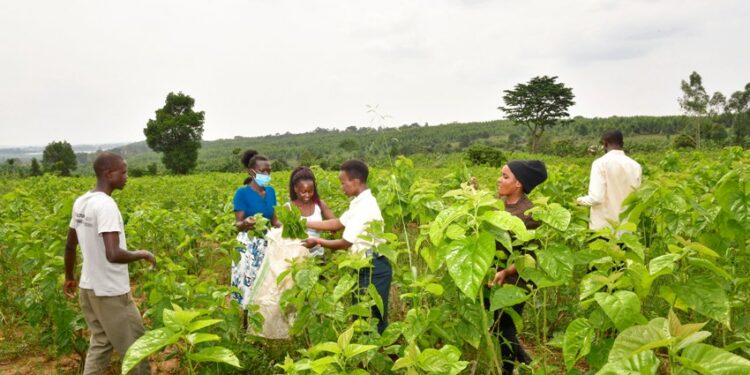By Nangoli Fred – PPU
At a distance, they look like tiny strips of white thread. But up close, you see some forward movements as the silkworms measuring about 35cm nibble at green mulberry leaves. The silkworm looks nothing like silk. Where the fabric is light, lustrous and delicate, the caterpillar is fat and grayish. A few meters away from a writhing mass of these worms, you can hear them joyfully devouring leaves in what sounds like a light rainfall on an old tinned roof.
Michael Wekhola, a 23 year old silkworm specialist in Namasumbi in Mukono district has been attending to these caterpillars for close to three years now and has watched them feed countless times every day. And it is from these worms that he has been getting his bread and butter as the worms give rise to cocoons, the much needed raw materials for the beautiful silk garments, desired by millions of people across the globe.
In the adjacent room, another young man, Oscar Biiyi 25 is busy harvesting cocoons and placing them in baskets. His face is beaming with excitement as he counts the benefit of a successful harvest.
“The process of breeding silkworms from the beginning to and after the cocoon is woven and harvested is very interesting and spectacular,” he says with another wide smile.
“We have to ensure that we harvest most of these cocoons today because any slight delay means that the cocoons will turn into butterflies and all the long efforts we have put in will be a total waste,” he reveals stressing that no silk materials can be realized once the cocoons develop into butterflies.
According to Biiya, putting silkworms in a two-story wooden structure, feeding them with mulberry leaves, and weaving cocoons around the worms takes some time. “But the end product of all these efforts is a master piece of textile” Wekhola chips in as he joins Biiyi in harvesting cocoons.
Despite their small size, silkworms have played a significant role in shaping cultures across the world as silk, which is possibly the most beautiful, most delicate and most lustrous material ever discovered by mankind continues to rule the garment industry as the “queen of textiles.” It’s natural
Sheen, light weight, soft touch and high durability makes it the most elegant textile. In Mukono, like many other areas in Uganda, silk farming is increasingly becoming a central source of income for hundreds of families. One such organization that is taking a leading role in promoting and engaging hundreds of households into silk farming is the Tropical Institute of Development Innovations (TRIDI) based in Namasumbi in Mukono. The innovation firm which has kick started silkworm farming activities in over 18 districts is Uganda is currently employing over 900 Ugandans in the silk industry as mulberry cultivators, leaf harvesters, silk worm rearing, reeling, twisting and weaving among others.
The project is one of the Presidential initiatives to transform Uganda from subsistence economy to an industrialized nation. It is also one of the countries efforts in implementing textile and industrial policies for export promotion and import substitution.
And indeed with support from the government of Uganda, TRIDI has also assembled two silk making factories in Sheema and Kween districts and will soon be producing and unveiling its first silk fabrics onto the local and international market once installation of the machines is complete.
Dr. Clet Wandui Masiga the principal Investigator at TRIDI says sericulture or silk farming is an ecofriendly agro based labour intensive and commercially attractive economic activity falling under cottage and small scale sectors. He says sericulture is a long chain industry from mulberry cultivation to fabric making and is also the only cash crop which provides frequent and attractive returns all year round.
He says in a move to enhance commercial production of silk across the country, the organization has established over 627 acres of mulberry plantations and productions at 25 stations spread across 18 districts in the different regions of Uganda. He says silkworm rearing in particular is going on in Sheema, Mukono, Kamuli, Pallisa, Iganga and Kayunga and cocoons from these areas are being collected in one central area in preparation for mass silk production when the newly installed machines in Sheema and Kween become operational.
Masiga recently displayed TRIDI’s innovations at the just concluded Science and Innovation show at Kololo where he attracted the attention of President Museveni who raised a number of questions on the progress of the silk project. The President also noted that he was impressed with the direction the country’s Science, Technology and Innovation portfolio was taking adding that he would do everything in his power to ensure the sector is funded.
“I am determined to make sure scientists working for the government are well paid and all positive efforts and innovations of our scientists will be funded either by the government directly or through Uganda Development Bank,” the President stressed as he interacted with the innovators.
But while industrialization is one of the key areas that the National Resistance Movement (NRM) government is focusing on to transform Uganda’s economy and push the country into the middle-income status, one wonders what government has done for TRIDI and its ongoing silk innovations.
Masiga says during the 2017/2018 financial year, government set up an innovation fund and TRIDI was among the 17 innovators that were selected to benefit from the fund. That financial year, TRIDI received sh1.5billion from government which was used to set up experimental fields in Sheema district where they also set up mulberry plantations to feed the silkworms.
“We identified Sheema as a very conducive area for silkworm farming while using the GPS technologies that we employed in mapping out areas which are suitable for mulberry production and silkworm farming across the country. That is how we identified Sheema in the first place before identifying other areas later on,” reveals Masiga who is also participating the feeding and harvesting of ready cocoons at their farm in Namasumbi today.
“By scanning the environment with this same technology, we were also able to identify which kind of production models would be used to produce the best mulberry needed for feeding the silk worms,” he adds.
During the 2019/2020 financial year, the silk innovators received their second batch of financial support of sh5bn from the government through the Ministry of Science, Technology and Innovation.
“These funds came after government had evaluated our progress on the ground. We proved that this was an income generating activity which was increasingly creating employment opportunities for people in places we had established in. we demonstrated that more jobs would be created as the project expanded to many other parts of the country, not forgetting those who will be working in the processing plants,” he explains further.
According to Masiga, the innovation firm used this second batch of funds to place an order for the purchase of two Silk processing machines from Hangshou City in China. They made a down payment of 30% of the funds towards the machines. And indeed during the financial year 2020/2021, the innovation firm received another batch of Shs.10billion shillings from government which was used to pay for the remaining balances to machine manufacturers in China. On completing payment, he says the machines were shipped and delivered to TRIDI. One set of the machines was installed in Sheema district while the second one was installed in Kween.
Today, Masiga says they have received a total of 21billion shillings from the NRM government which has greatly boosted their efforts to set up several investments in the silk industry including setting up the two factories in Sheema and Kween districts besides expanding their activities in 18 of the targeted 50 districts they have identified.
Presently TRIDI is carrying out silkworm farming in 24 of the 50 targeted districts in Uganda. These include among others Mukono, Nakaseke, Kayunga, Luwero, Kamuli, Iganga, Pallisa, Busia, Bukedea, Bulambuli, Lira, Otuke, Amorater, Padel, Agago, Nakasongola and Kitagata.
Masiga says government has decided to invest in silk because its value is 20 times more than cotton disclosing that the global demand of silk fabrics is far more than its supply.
“Globally, China produces 75% of the world’s silk followed by India at 20% while the other 5% is shared by all the other silk producing countries including Uganda.”
Today, he says they need a minimum of 50,000 acres of land under mulberry to be able to feed the silkworm and produce enough silk yarn. He revealed that already they have received requests from global brands like Mac and Spenser of UK, Pierre carbins from France to supply them with about 200 tons of silk yarn every month.
According to Masiga, more than a million jobs will also be created as TRIDI continues to extend silk farming to many other districts of Uganda in her bid to meet the high demand. But to accomplish this investment, he says it requires approximately Shs.700bn saying out of that investment, they will have an output of at least US$100million annually.
“Our projection is US$300m which will bring us to almost one trillion shillings through the export of silk yarn every year. And if we go into making the final clothes of which equipment we have already secured, we will be making about sh3trillions per year,” he explains.
Silkworm eggs are lemon yellow when laid, but turn white or black within a few days. White eggs are infertile and black eggs are fertile. Once laid, eggs typically hatch in about 2 weeks, but the incubation period is temperature dependent. Freshly hatched caterpillars (larvae), also called silkworms, look like small black strings. Once hatched, silkworm larvae normally eat only mulberry leaves. The caterpillars molt 4 times passing through 5 larval instars (an instar is the stage between molts) over a period of 23 to 28 days. After the 4th molt, the caterpillar begins to secrete a single, continuous silk fiber through its salivary gland. The strand of silk produced by a silkworm is usually about 1.5kms long.
Presently Masiga says using the bivoltine cocoons, one kilogram of silk yarn is equivalent to 6kgs of cocoons. He says from just one acre of mulberry per year, they are able to harvest 1080kgs of cocoons from six cycles of silkworm rearing which will result in 180kgs of silk yarn produced per year using the current innovations. He says this will earn them up to sh33.7millions from every single acre of mulberry annually.
Do you have a story in your community or an opinion to share with us: Email us at editorial@watchdoguganda.com













